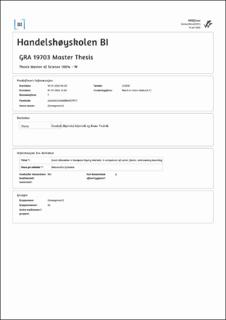| dc.description.abstract | With the evolution of index-based investing in the past decades, we
investigate three investment universes consisting of sector, factor, and
country indices in the European equity market. We employ several asset
allocation strategies such as 1/N, Risk-Parity, Minimum-Variance,
Mean-Variance, Bayes-Stein, and Kelly Growth. We then investigate
and extend the research on blended portfolios (Ghayur et. al, 2018)
by introducing countries and joint blending. In the period from 2002-
2021, we find that factor portfolios dominates sector and country portfolios
both in expansions and recessions when short-selling is disallowed.
When short-selling is allowed, country portfolios often outperform factors
across several performance measures. Contrary to previous findings,
we find that sector investing do not yield better performance when
diversification is needed, and is overall the weakest dimension in performance.
1 | en_US |
